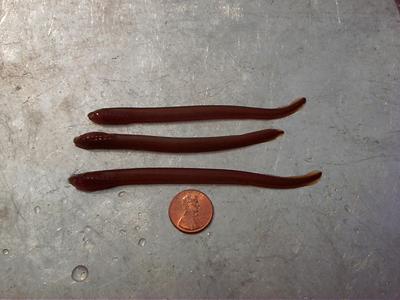Note: This is the second of a two-part story about sea lampreys and pesticide treatment in the LaPlatte River.
Sea lampreys are prehistoric-looking beasts, snakelike, with round mouths full of rows of sharp teeth. They are invasive – or maybe they’re not. They wound other fish, including game species like salmon and trout, to feed on them. And sea lamprey have found themselves right at home in the LaPlatte River, which flows through Shelburne, Charlotte and Hinesburg.
Notes US Fish and Wildlife Service Sea Lamprey Control Program Manager Bradley Young, “(The LaPlatte River) has gotten just packed with lamprey. It’s one of the biggest rivers in Vermont right now for lamprey population.”
The sea lampreys have caught the attention of fish and wildlife officials, as well as local fishing enthusiasts, because of their detrimental effect on other fish with whom they share the water. The lampreys’ impact is both ecological and economic.
“Lake trout and lake salmon are traditionally the apex predators in the lake, so we’re trying to maintain the ecological balance in the lake, by keeping those species in there,” notes Young, “but certainly they are very popular game fish as well, and we want to keep fishermen happy… it brings a lot to the economy of Vermont, to have people fishing for those fish.” Lake sturgeon, too, are part of this ecosystem. The ecosystem doesn’t stop at the lake’s edge, however. The sea lampreys emerge from the lake to spawn in tributary rivers and streams, including the LaPlatte River. This has prompted the initiation of lamprey-killing pesticide, or lampricide, known as TFM, in the heretofore-untreated LaPlatte River.
Ironically, Young suspects that the reason for the large population in the LaPlatte is the success of the lampricide program elsewhere. Young explains that adult sea lamprey sense a pheromone in rivers where many larval lamprey live: if lots of young lamprey live there, it must be a good place to spawn.
“I think probably what happened is as we started controlling other rivers in the Lake Champlain basin, we started suppressing the number of lamprey in other rivers where they previously were much higher,” Young explains, “and as those numbers went down, the relative number of the larvae in the LaPlatte was higher, and became a greater attractant to the population of adult sea lamprey.” Larval lampreys remain in these waterways for four years before entering Lake Champlain, meaning lampricide treatment of a stream or river will wipe out several years’ offspring at once, Vermont Fish and Wildlife Commissioner Louis Porter says. With other treated rivers quickly becoming a no-go for sea lamprey, the LaPlatte probably began to look more like a safe haven to adult sea lampreys looking for a place to spawn.
There are actually four species of lamprey in Lake Champlain, but the sea lamprey is the one with the ugly reputation. Says Young, “Even people that don’t think they’re invasive still agree that they’re just horrid-looking.”
The question of whether sea lampreys are native or invasive is a question of history and timescale. “Either they’re 10,000 years old or they’re 80 years old,” says Young. Some researchers, looking at genetic data, believe the Lake Champlain sea lamprey are a remnant population of Atlantic sea lampreys, left behind as the Champlain Sea receded 10,000 years ago, Young explains. Other workers, looking at much more recent historical data such as old fishery reports, think the animals made their way up from the Hudson River in the last 100 years via then-newly-constructed canals.
Whether they are an invasive or a native species, the sea lampreys are here and require management, says Porter. “From a practical standpoint, it doesn’t make all that much difference. We are not trying to eliminate lamprey in Lake Champlain. We’re trying to manage their populations, and we manage the populations of a lot of species, some native and some not.”
In addition to questions surrounding potential health impacts of TFM, there is the possibility of other, so-called “non-target” species, particularly fish, being affected by the lampricide. “That has happened in the past, and we monitor for that,” says Porter.
Department of Environmental Conservation (DEC) Deputy Commissioner George Desch points out that the DEC is proposing a workgroup, established by the Agency of Natural Resources, to look into the lampricide program’s effectiveness and effects on other species, longer-term.














(0) comments
Welcome to the discussion.
Log In
Keep it clean. Please avoid obscene, vulgar, lewd, racist or sexual language.
PLEASE TURN OFF YOUR CAPS LOCK.
Don't threaten. Threats of harming another person will not be tolerated.
Be truthful. Don't knowingly lie about anyone or anything.
Be nice. No racism, sexism or any sort of -ism that is degrading to another person.
Be proactive. Use the "Report" link on each comment to let us know of abusive posts.
Share with us. We'd love to hear eyewitness accounts, the history behind an article.